1993 CHEVROLET CAVALIER belt
[x] Cancel search: beltPage 141 of 308
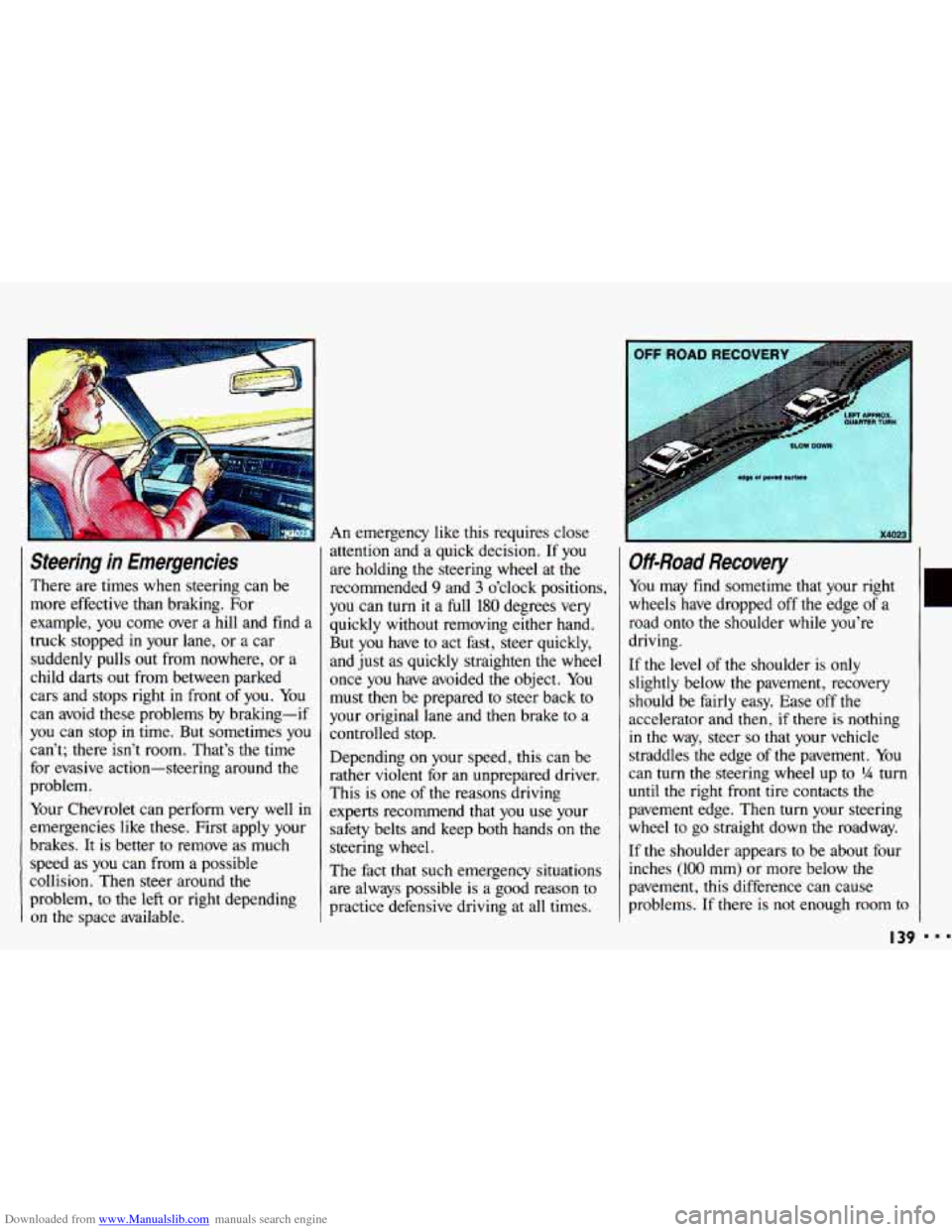
Downloaded from www.Manualslib.com manuals search engine I
I
-
Steering in Emergencies
There are times when steering can be
more effective than braking. For
example,
you come over a hill and find a
truck stopped in your lane, or a car
suddenly pulls out from nowhere, or a
child darts out from between parked
cars and stops right
in front of you. You
can avoid these problems by braking-if
you can stop in time. But sometimes
you
can’t; there isn’t room. That’s the time
for evasive action-steering around the
problem.
Your Chevrolet can perform very well in
emergencies like these. First apply your
brakes.
It is better to remove as much
speed
as you can from a possible
collision. Then steer around the
problem,
to the left or right depending
on the space available.
An emergency like this requires close
attention and a quick decision. If
you
are holding the steering wheel at the
recommended
9 and 3 o’clock positions,
you can turn it a full
180 degrees very
quickly without removing either hand.
But you have to act fast, steer quickly,
and just as quickly straighten the wheel
once
you have avoided the object. You
must then be prepared to steer back to
your original lane and then brake
to a
controlled stop.
Depending
on your speed, this can be
rather violent for an unprepared driver.
This is
one of the reasons driving
experts recommend that you use your
safety belts and keep both hands on the
steering wheel.
The fact that such emergency situations
are always possible is a good reason to
practice defensive driving at all times.
Off-Road Recovery
You may find sometime that your right
wheels have dropped off
the edge of a
road onto the shoulder while you’re
driving.
If
the level of the shoulder is only
slightly below the pavement, recovery
should be fairly easy. Ease
off the
accelerator and then,
if there is nothing
in the way, steer so that your vehicle
straddles the edge of the pavement. You
can turn the steering wheel
up to ?4 turn
until the right front tire contacts the
pavement edge. Then turn your steering
wheel to go straight down the roadway.
If the shoulder appears
to be about four
inches
(100 mm) or more below the
pavement, this difference can cause
problems. If there is
not enough room to
I39
Page 234 of 308
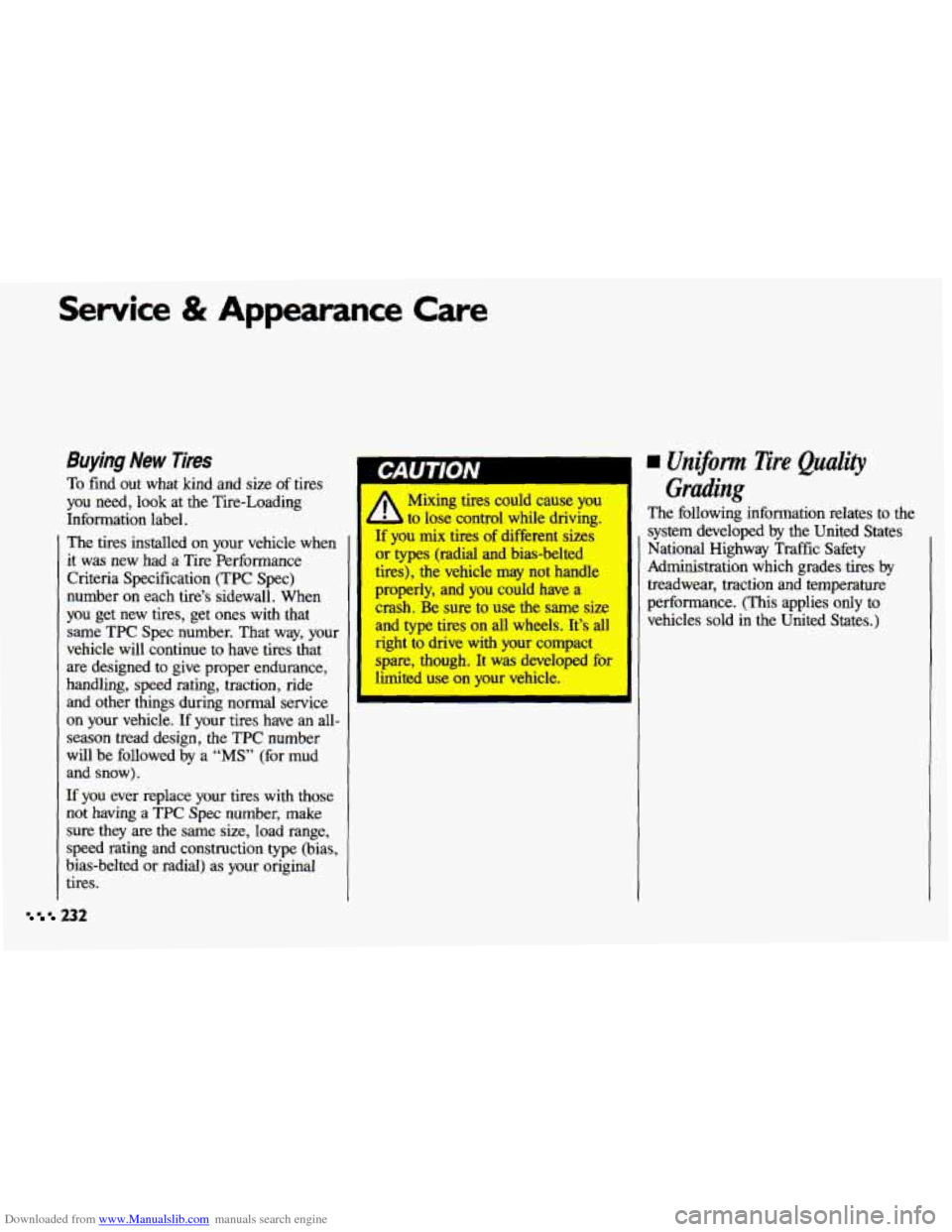
Downloaded from www.Manualslib.com manuals search engine Service & Appearance Care
Buying New Tires
To find out what kind and size of tires
you need, look at the Tire-Loading
Information label.
The tires installed on your vehicle when
it was new had a Tire Performance
Criteria Specification (TPC Spec)
number on each tire’s sidewall. When
you get new tires, get ones with that
same
TPC Spec number. That way, your
vehicle will continue to have tires that are designed to give proper endurance,
handling, speed rating, traction, ride
and other things during normal service
on your vehicle. If your tires have an all- season tread design, the TPC number
will be followed by a
“MS” (for mud
and snow).
If you ever replace your tires with those
not having a TPC Spec number, make
sure they are the same size, load range,
speed rating and construction type (bias,
bias-belted or radial) as your original
tires.
Mixing tires could cau’se you
d to lose control while driving.
If you mix tires of different sizes
or types (radial and bias-belted
tires), the vehicle
may not handle
properly,
and you could have a
crash. Be sure to use the same size
and type tires on all wheels. It’s all
right to drive with your compact
spare, though. It was developed for
limited use on your vehicle.
I I
Unijiorpn Tire Quality
Grading
The following information relates to the
system developed by the United States
National Highway Traffic Safety
Administration which grades tires by
treadwear, traction and temperature
performance. (This applies only to vehicles sold in the United States.)
232
Page 242 of 308
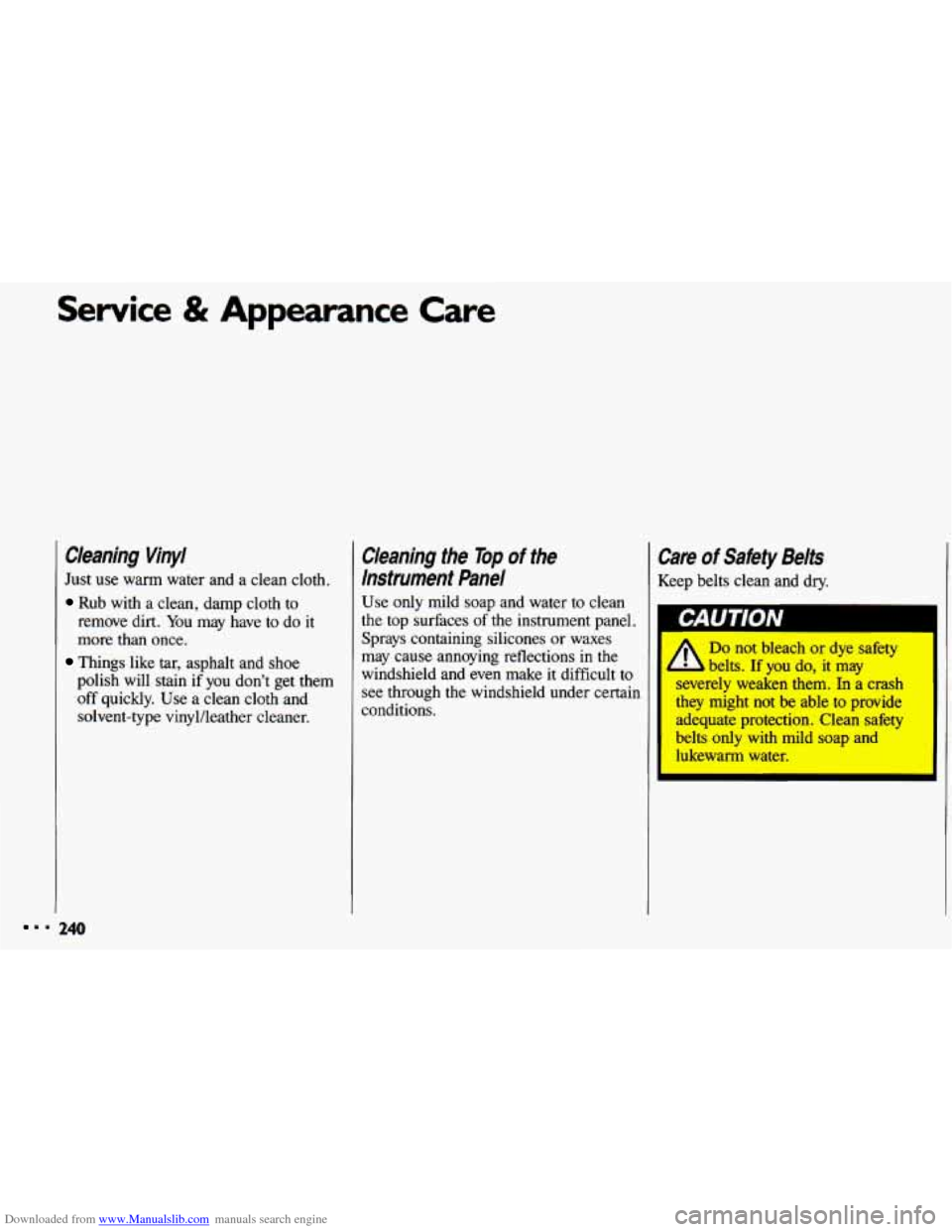
Downloaded from www.Manualslib.com manuals search engine Service & Appearance Care
Cleaning Vinyl
Just use warm water and a clean cloth.
Rub with a clean, damp cloth to
remove dirt.
You may have to do it
more than once.
polish will stain if you don’t get them
off quickly. Use a clean cloth and
solvent-type vinyl/leather cleaner.
Things like tar, asphalt and shoe
Cleaning the Top of the
instrument Panel
Use only mild soap and water to clean
the top surfaces of the instrument panel.
Sprays containing silicones or waxes
may cause annoying reflections
in the
windshield and even make it difficult to
see through the windshield under certain
conditions.
Care of Safety Belts
Keep belts clean and dry.
CAUTION
Do not bleach or dye s&ty
severely weaken them. h a crash
they might not be able to provide
adequate protection. Clean safety
belts only with mild soap and
lukewarm water.
- belts. If you do, it may
. . 240
Page 256 of 308
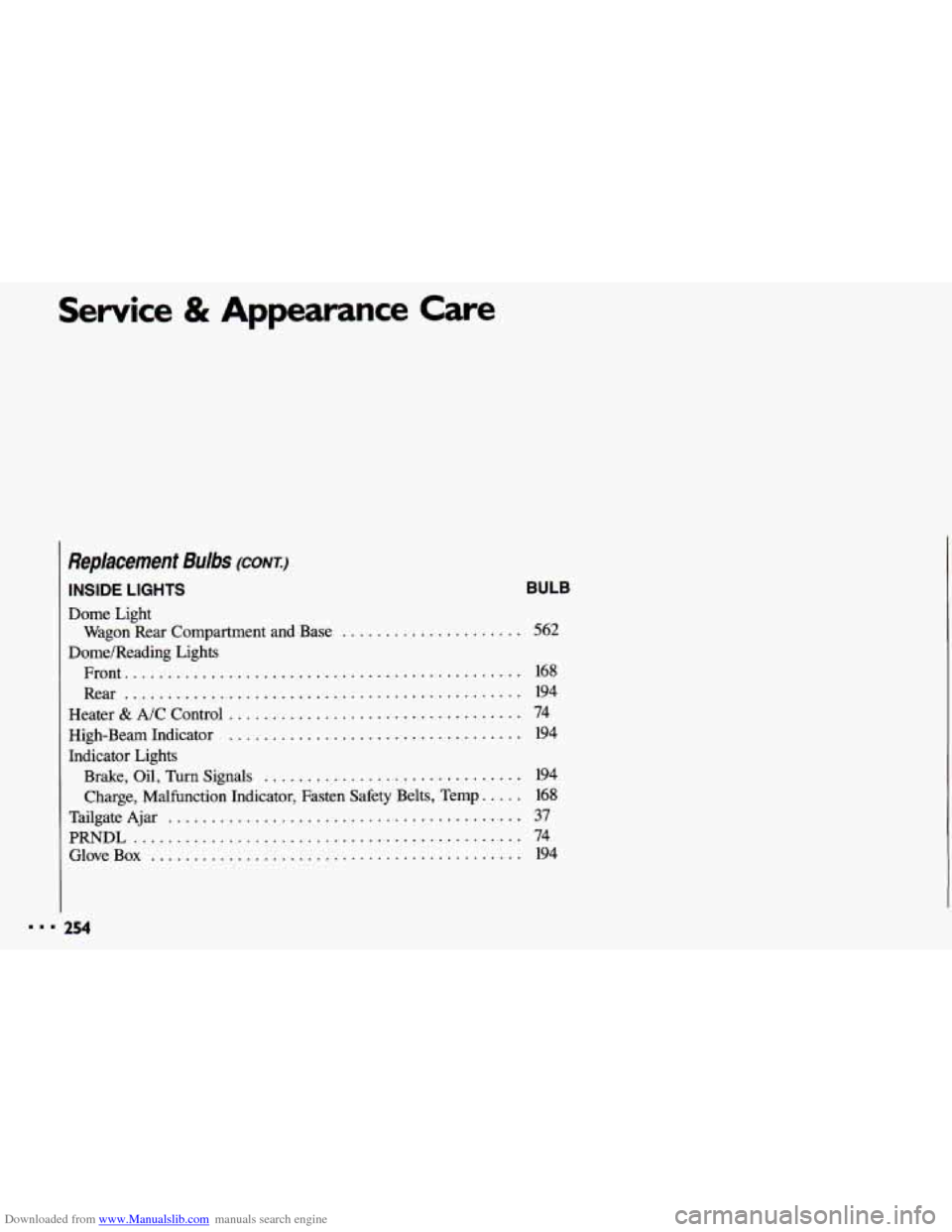
Downloaded from www.Manualslib.com manuals search engine Service & Appearance Care
Replacement Bulbs (CONT.)
INSIDE LIGHTS
Dome Light
Dome/Reading Lights Wagon Rear
Compartment and Base
.....................
Front ..............................................
Rear ..............................................
Heater & A/C Control ..................................
Indicator Lights High-Beam Indicator
..................................
Brake. Oil. Turn Signals ..............................
Tailgate Ajar .........................................
Charge. Malfunction Indicator. Fasten Safety Belts. Temp .....
PRNDL .............................................
GloveBox ...........................................
I’ A 254
BULB
562
168
194
74
194
194
168
37
74
194
Page 266 of 308
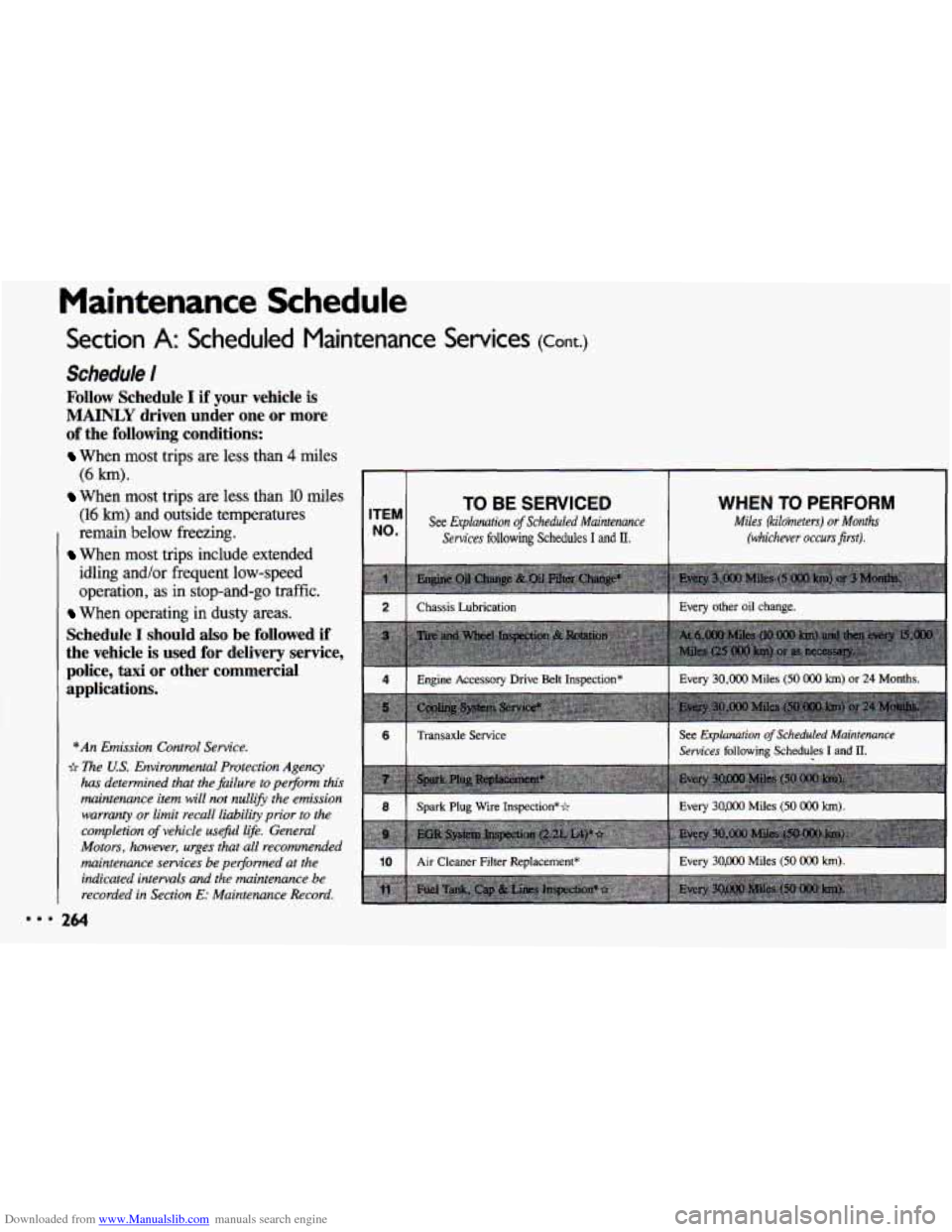
Downloaded from www.Manualslib.com manuals search engine Maintenance Schedule
Section A: Scheduled Maintenance Services (Cont.)
Schedule I
Follow Schedule I if your vehicle is
MAINLY driven under one or more
of the following conditions:
When most trips are less than 4 miles
When most trips are less than 10 miles
(6 km).
(16 km) and outside temperatures
remain below freezing.
When most trips include extended
idling and/or frequent low-speed
operation, as in stop-and-go traffic.
When operating in dusty ,areas.
Schedule I should also be followed if
the vehicle is used for delivery service,
police, taxi
or other commercial
applications.
*An Emission Control Service.
b me US. Environmental Protection Agency
has determined that the failure to pelform this
maintenance item will not
nullifi the emission
warranty or limit recall liability prior to the
completion
of vehicle use&/ life. General
Motors, however, urges that all recommended maintenance services be performed at the indicated intervals and the maintenance be
recorded in Section
E: Maintenance Record.
I I
TO BE SERVICED ITEM
NO. See Explanation of Scheduled Maintenance
Sewices
following Schedules I and II.
WHEN TO PERFORM
Miles (kiloineters) or Months
(whichever
occurs first).
Chassis Lubrication 1 Every other oil change. I
I Engine Accessory Drive Belt Inspection* I Every 30,000 Miles (50 OOO km) or 24 Months. I
(ll
Transaxle Service See Explanation of Scheduled Maintenance
Services
following Schedules I and 11.
I 10 I Air Cleaner Filter Replacement* I Every 30,000 Miles (50 000 km). I
264
Page 268 of 308

Downloaded from www.Manualslib.com manuals search engine Maintenance Schedule
Section A: Scheduled Maintenance Services (Cont.)
Schedule I/
Follow Schedule II ONLY if none of
the driving conditions specified in Schedule
I apply.
*An Emission Control Service.
~2 The US. Environmental Protection Agency
has determined that the failure to pelform this
maintenance item will not nullify the emission warranty or limit recall liability prior
to the
completion
of vehicle useful life. General
Motors, however, urges that all recommended
maintenance services be pei$ormed at the indicated intervals and the maintenance be
recorded in Section E: Maintenance Record.
TO BE SERVICED
See Explanation of Scheduled Maintenance
Services
following Schedules I and II.
WHEN TO PERFORM
Miles (kilometers) or Months
(whichever occursfirst).
I 2 I Chassis Lubrication I Every 7,500 Miles (12 500 km) or 12 Months.
I 4 I Engine Accessory Drive Belt Inspection* I Every 30,000 Miles (50 OOO km) or 24 Months.
16/
Transaxle Service See Explanation of Scheduled Maintenance Services
following Schedules I and 11.
(!-Spark Plug wire Inspection** I Every 30,000 Miles (50 OOO km).
F] Air Cleaner Filter Replacement* 1 Every 30,000 Miles (50 OOO km).
266
Page 271 of 308

Downloaded from www.Manualslib.com manuals search engine ITEM
NO. SERVICE ITEM NO. SERVICE
4
5
Engine
Accessory Drive Belt(s) Inspection*-
Inspect the belt(s) for cracks, fraying, wear and
proper tension. Replace as needed.
Cooling System Service*-Drain, flush and refill
the system with
new or approved recycled coolant
conforming to
GM Specification 1825M. Keep
coolant at the proper mixture as specified. See the
Index under Coolant. This provides proper freeze
protection, corrosion inhibitor level and engine
operating temperature.
Inspect hoses and replace if they are cracked,
swollen or deteriorated. Tighten screw-type hose
clamps. Clean the outside of the radiator and air
conditioning condenser. Wash
the pressure cap and
neck.
To help ensure proper operation, we recommend a
pressure test of both the cooling system and the
pressure cap.
6
7
8
9
Transaxle Service-For manual transaxles, fluid
doesn't require changing.
For automatic transaxles, change both the fluid and
filter every
15,000 miles (25 000 km) if the vehicle
is mainly driven under one or more of these
conditions:
In heavy city traffic where the outside temperature
In hilly or mountainous terrain.
Uses such as found in taxi, police car or delivery
regularly reaches
90" F (32" C) or higher.
service.
If you do not use your vehicle under any of
these conditions, change both the fluid and filter
every 100,000 miles (160
0oO km).
Spark Plug Replacement*-Replace spark plugs
with the proper type. See
the Index under
Replacement Parts.
Spark Plug Wire Inspection* *-Inspect for
burns, cracks or other damage. Check the boot
fit
at the coils and at the spark plugs. Replace wires as
needed.
Exhaust Gas Recirculation (EGR) System
Inspection
(2.2L L4 Code 4 engine)" *-Conduct
the
EGR system service as described in the service
manual. To purchase a service manual
, see the
Index under Service Publications.
Page 297 of 308
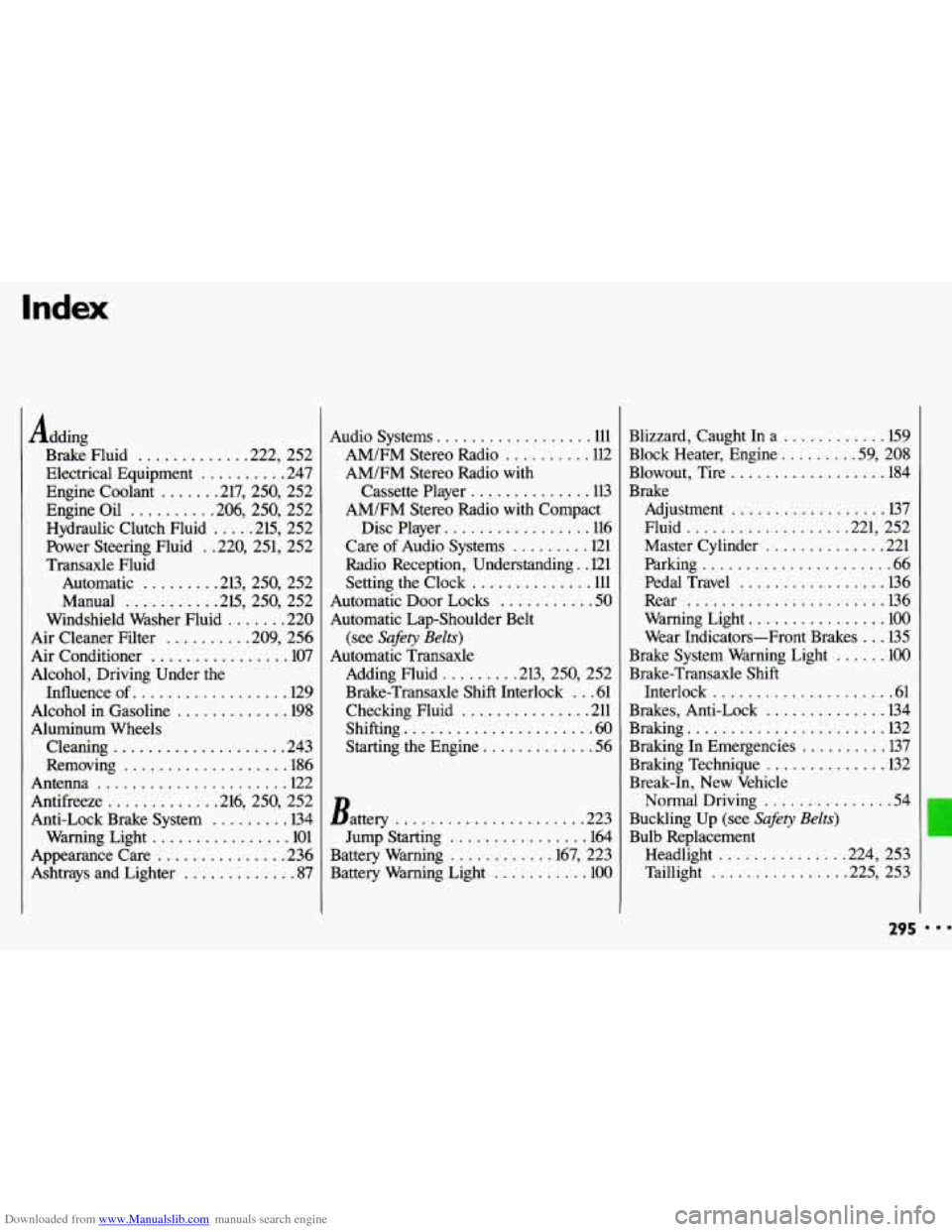
Downloaded from www.Manualslib.com manuals search engine Index
Adding Brake Fluid
............ .222. 252
Electrical Equipment
.......... 247
Engine Coolant
...... .217. 250. 252
Engine Oil
......... .206. 250. 252
Hydraulic Clutch Fluid
.... .2l5. 252
Power Steering Fluid
. .220. 251. 252
Transaxle Fluid Autornatic
........ .213. 250. 252
Manual
.......... .2l5. 250. 252
Windshield Washer Fluid
....... 220
Air Cleaner Filter
......... .209. 256
Air Conditioner
................ 107
Alcohol. Driving Under the Influence of
.................. 129
Alcohol in Gasoline
............. 198
Aluminum Wheels
Cleaning
.................... 243
Removing
................... 186
Antenna
...................... 122
Antifreeze
............ .216. 250. 252
Anti-Lock Brake System
......... 134
Warning Light
................ 101
Appearance Care
............... 236
Ashtrays and Lighter
............. 87
Audio Systems .................. 111
AM/FM Stereo Radio
.......... 112
AM/FM Stereo Radio with
Cassette Player
.............. 113
AM/FM Stereo Radio with Compact
Disc Player
................. 116
Care
of Audio Systems ......... 121
Radio Reception. Understanding
. . 121
Setting the Clock
.............. 111
Automatic Door Locks
........... 50
Automatic Lap-Shoulder Belt
(see
Safety Belts)
Automatic Transaxle
Adding Fluid
........ .213, 250, 252
Brake-Transaxle Shift Interlock
... 61
Checking Fluid
............... 211
Shifting
...................... 60
Starting the Engine ............. 56
Battery ...................... 223
Jump Starting
................ 164
Battery Warning
........... .167. 223
Battery Warning Light
........... 100 Blizzard. Caught
In a
............ 159
Block Heater. Engine
........ .59. 208
Blowout. Tire
.................. 184
Brake Adjustment
.................. 137
Fluid
.................. .221. 252
Master Cylinder
.............. 221
Parking
...................... 66
Pedal Travel
................. 136
Rear
....................... -136
Warning Light ................ 100
Wear Indicators-Front Brakes ... 135
Brake System Warning Light
...... 100
Brake-Transaxle Shift
Interlock
..................... 61
Brakes. Anti-Lock
.............. 134
Braking
....................... 132
Braking In Emergencies
.......... 137
Braking Technique
.............. 132
Break-In. New Vehicle
Normal Driving ............... 54
Buckling Up (see
Safety Belts)
Bulb Replacement
Headlight
.............. .224. 253
Taillight
............... .225. 253
295